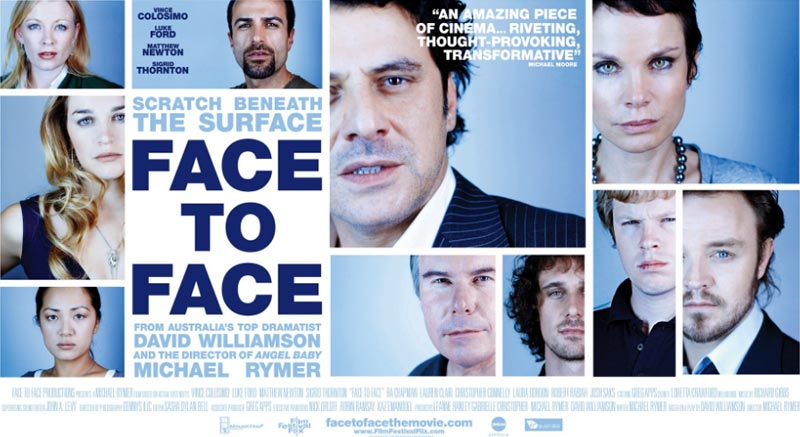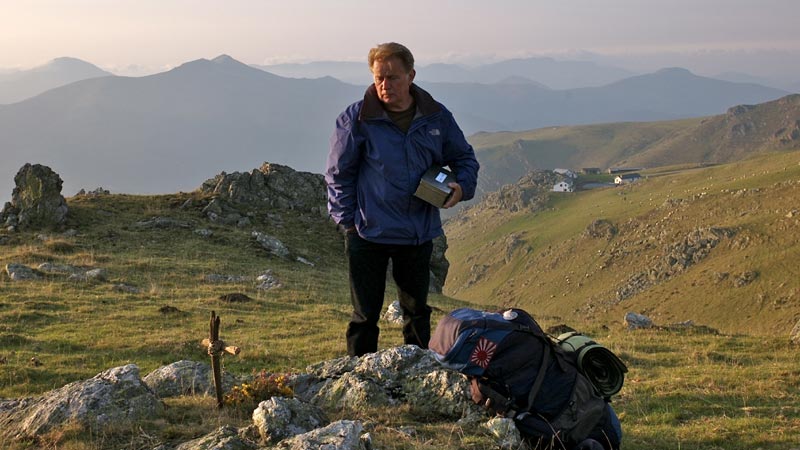Showing all posts about legacy
Trailer for Before Midnight, by Richard Linklater, with Julie Delpy, Ethan Hawke
9 April 2013
Richard Linklater, director of Dazed and Confused, A Scanner Darkly, and Bernie, collaborates once more with Julie Delpy and Ethan Hawke to make Before Midnight, the third title in the Before Sunrise and Before Sunset, series of films.
No word of an Australian release as yet (I heard 13 June whispered as a suggestion), but in the meantime check out the trailer. I can’t say what piqued my interest in these films since first seeing them on DVD eight or nine years ago. Eurorail maybe? Peneda-Gerês? County Bondi?
It looks like he missed the flight…
Originally published Tuesday 9 April 2013.
RELATED CONTENT
Ethan Hawke, film, Julie Delpy, legacy, Richard Linklater, video
The island hut on the Drina River, an island paradise to call our own
18 March 2013

Photo by Tanja Mitrovic (CC BY-SA 4.0).
Forty-five years ago some people swimming in the Drina River, in western Serbia, decided that a small island in the middle of the river needed to offer more than merely somewhere to relax mid-swim. Eventually they went on to build a one room house on the rock-island.
Despite appearing to perch quite precariously on the island, the house is quite sturdy, and has withstood numerous severe storms and floods.
Originally published Wednesday 18 March 2013, with subsequent revisions, updates to lapsed URLs, etc.
RELATED CONTENT
Single microbe theory, was it a bug that killed off the dinosaurs?
20 December 2012
The mass extinction that killed off ninety percent of animal, plant, and insect species on Earth around two-hundred-and-fifty-one million years ago, could be attributable to an ocean residing microbe called methanosarcina, thinks Massachusetts Institute of Technology researcher Daniel Rothman:
Called methanosarcina, this sea-dwelling microbe is responsible for most of the methane produced biologically even today. Rothman and his team discovered that methanosarcina developed the ability to produce methane 231 million years ago. While that ability came around too late to be single-handedly responsible for the link. However, mathanosarcina requires nickel in order to produce methane quickly. Nickel levels spiked almost 251 million years ago, likely because of a spike in Siberian lava from the volcanoes themselves. This indicates that methanosarcina was directly responsible for producing the methane that killed off an overwhelming majority of the Earth\’s species.
Bound to be hotly disputed but will surely make for a talking point or two over the year-end break.
Originally published Thursday 20 December 2012.
RELATED CONTENT
Liberal Arts, a film by Josh Radnor, with Elizabeth Olsen, Richard Jenkins
10 December 2012
Say what you will about Liberal Arts degrees, ridiculed by some as glorified courses in general knowledge that effectively leave students without a real education, but like it or not, life, or the university of hard knocks, eventually makes degree holders out of us all. Even if our alma mater is one we never really graduate from.
This is something Jesse (Josh Radnor), discovers in Liberal Arts, trailer, also Radnor’s second directing effort following 2010’s Happythankyoumoreplease, when he returns to his former college for the retirement dinner of Peter Hoberg (Richard Jenkins), a professor he greatly respected during his days as an under-graduate.
Now 35, trapped in a job in New York that offers no fulfilment, and single again after another woman walked out on him, Jesse is delighted to be back on his leafy old stomping ground, at Ohio’s Kenyon College, once more. While dining later with friends of Peter’s, Jesse meets Zibby (Elizabeth Olsen), a 19 year old sophomore at the university.
In the days and weeks that follow, Jesse and Zibby discover, despite their age difference, that they have numerous shared interests through the hand written letters they exchange after Jesse returns to New York. And while both realise that a romantic attraction is forming, Jesse is reluctant to be any more than a friend to Zibby.
It is the reticence to see Jesse and Zibby, who, when in her element, appears to be wiser to the world than her older would-be beau, form a serious relationship, that takes away much of the substance Liberal Arts could have had. The question is though, was this out of a fear of offending certain viewer sensibilities, or not?
Otherwise Radnor’s second feature, even if it gets a little muddled along the way, bestows something of a general knowledge education in itself, and of course more, even if it regards so-called May to December romances as unheard of. But you haven’t lived, or languished, unless you’ve studied the Liberal Arts, and dated beyond your years, and that much it gets right.
Originally published Monday 10 December 2012, with subsequent revisions, updates to lapsed URLs, etc.
RELATED CONTENT
Allison Janney, Elizabeth Olsen, film, Josh Radnor, legacy, Richard Jenkins
Face to Face, a film by Michael Rymer, with Matthew Newton and Luke Ford
12 September 2012

Face to Face (trailer), a drama, is the latest feature of Australian film director Michael Rymer (Perfume, Queen of the Damned), who also produced the Battlestar Galactica TV shows from 2003 to 2009. Face to Face is Rymer’s film adaptation of the play of the same name, written by Queensland based playwright David Williamson, in 2000.
Face to Face traces the proceedings of a community conference, a trial scheme that takes minor matters out of the court system, and brings together all who are party to a dispute. The process allows everyone to tell their side of the story, under the auspices of a moderator, who later drafts a resolution that binds on all involved.
Wayne (Luke Ford), a former employee of a Melbourne scaffolding company, is a hot headed young man who lost his job as result of violent outbursts and inappropriate conduct in the workplace. Luke finds himself before a community conference after ramming his ute into the car of ex-boss, Greg Baldoni (Vince Colosimo).
Wayne is supported by his mother Maureen (Lauren Clair), and best friend Barry (Josh Saks). Meanwhile Greg’s wife Claire (Sigrid Thornton), Julie (Laura Gordon) his secretary, Therese (Ra Chapman) the accountant, Richard (Chris Connelly) the foreman, and Hakim (Robert Rabiah) a worker, turn out for the company.
As the conference progresses though, Jack (Matthew Newton) who is moderating, often struggles to control tensions in the room. As the complicated series of events that led to Wayne’s outbursts work their way to the surface, tempers fray and emotions erupt, but it becomes clear there is far more to his actions than meet the eye.
For a drama that for the most part features ten people sitting in just one room for almost ninety minutes, Face to Face is utterly compelling. The key to this intrigue lies in both its strong characters, the ceaseless allure of gossip, together with the voyeuristic pleasure of witnessing people’s dirty laundry being aired in public.
In opening a can of worms that leaves just about everyone present embarrassed to a greater or lesser degree, Face to Face is a reminder that there are always two sides, maybe more, to every story. Robust performances, solid scripting, together with a deprecating humour, combine to create intense, gripping, fly on the wall style drama.
Originally published Wednesday 12 September 2012.
RELATED CONTENT
film, legacy, Luke Ford, Matthew Newton, Michael Rymer
Takeaway coffee cups that let you have your cake and eat it
30 July 2012
I’m all for reusable takeaway coffee cups, or keep cups, in principle, after all we should be trying to conserve resources whenever possible. Thing is I’m not always carrying mine — if I can even find it some days — so the question remains, how not to be too wasteful while still ordering take out coffee, or your beverage of choice?
Edible coffee cups however, as designed by Enrique Luis Sardi, and made from biscuit, or cookie mix, with a sugar icing lining that stops the coffee steeping away, may be the solution.
If these cups could also be made with other food stuffs, such as say banana or raisin bread, then we might be able to significantly cut back on single-use disposable cups.
Originally published Monday 30 July 2012.
RELATED CONTENT
The billboard artworks of Robert Montgomery
8 June 2012
London based artist Robert Montgomery takes billboards, both in use and disused, and turns them into oversize canvases to make a variety of observations on day to day life.
Originally published Friday 8 June 2012.
RELATED CONTENT
art, legacy, Robert Montgomery
When galaxies collide, coming to the night sky in four billion years
4 June 2012
Several billion years hence our galaxy, the Milky Way, will collide with galactic neighbour Andromeda, and form a new entity some are calling Milkomeda. This NASA image depicts key steps in the process, and if nothing else will transform the night sky into a visual spectacle.
Not that anyone will probably be around to think about it anyway, but the night sky will have far less appeal once the merger is complete. The bright white haze (in the last frame) that will eventually take the place of the Milky Way (first frame) looks a little bland to me.
Via NASA Science.
Originally published Monday 4 June 2012.
RELATED CONTENT
astronomy, legacy, milkomeda, Milky Way
French illustrator Mega’s new take on the alphabet
14 May 2012

Image courtesy of Mega.
Paris based illustrator and street artist Mega, whose work I’ve mentioned before, recently launched I Just Murdered The Alphabet, a new project that will see him create a new illustration each day for five months.
Inspired variously by graffiti, sign painting, and psychedelic art, Mega’s new series of works are a tribute to hip-hop culture, and also an introduction to an intriguing, though imaginary, tribe that seeks to set itself apart from mainstream society.
Originally published Monday 14 May 2012.
RELATED CONTENT
The Way, a film by Emilio Estevez, with Martin Sheen, James Nesbitt
23 April 2012

Still from The Way, directed by Emilio Estevez.
People have been walking the Camino de Santiago, or Camino, an 800 kilometre long track from the Pyrenees in France, to the Cathedral of Santiago de Compostela, in the Spanish town Galicia, for over a thousand years. Many are Christian pilgrims on spiritual retreats, while others walk the scenic pathway purely for leisure.
American eye doctor Tom Avery (Martin Sheen) finds himself on the historic trail for other reasons however, in The Way (trailer), the latest feature of American filmmaker Emilio Estevez (The War at Home, Bobby). Estevez also plays Tom’s adult son, the free-spirited Daniel, who dies during a storm soon after embarking on the long trek.
Intent on walking the path alone in remembrance of Daniel, Tom isn’t exactly overjoyed to run into the same people repeatedly. They include Joost (Yorick van Wageningen), a Dutchman trying to lose weight, Sarah (Deborah Kara Unger), a Canadian escaping from an abusive marriage, and Jack (James Nesbitt), a struggling Irish writer.
The four eventually end up walking as a group, and in their own ways are able to be of help to each other. Tom however remains the most aloof of the quartet, and the most prone to bad tempered outbursts, as he struggles to come to terms with his grief, while harbouring a lingering ambivalence towards his trekking companions.
On one hand The Way is a warming portrayal the ancient Camino, and the people who travel along it, and their quest for whatever it is that they are seeking. Many of the situations that Tom and his co-walkers find themselves in will doubtless be familiar to anyone who has spent time backpacking, regardless of where they’ve been.
Yet it’s as if the grimness of Tom’s trudge, and the varying despair of those accompanying him, wasn’t quite enough for the screenwriters, who seemed to decide the story was want of a little more tension. The solution however, mainly in the form of Tom’s frequent meltdowns, comes across as contrived, and at odds with the consoling calm of the Camino.
Originally posted Monday 23 April 2012.
RELATED CONTENT
Deborah Kara Unger, Emilio Estevez, film, James Nesbitt, legacy, Martin Sheen, Yorick van Wageningen
